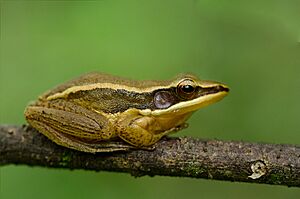Golden frog facts for kids
Quick facts for kids Golden frog |
|
|---|---|
 |
|
| Conservation status | |
| Scientific classification | |
| Genus: |
Indosylvirana
|
| Species: |
aurantiaca
|
| Synonyms | |
|
|
The golden frog (scientific name: Indosylvirana aurantiaca) is a special type of frog. It lives only in the Western Ghats of India. This means it is endemic to that area. People also call it the Trivandrum frog, the common wood frog, or the small wood frog.
Contents
Understanding the Golden Frog's Family
The golden frog belongs to a group of frogs called Indosylvirana. This group is part of the Ranidae family, which includes many common frogs.
Scientists once thought the golden frog was part of a different group called Hylarana. But after more studies, they learned it was unique. In 2014, research showed that the golden frog truly lives only in the Western Ghats.
For a while, some frogs found in Sri Lanka were thought to be golden frogs. They looked very similar! However, scientists later discovered these Sri Lankan frogs were actually a new species. They named this new species Indosylvirana serendipi. This shows how important it is for scientists to study animals closely.
The first person to describe the golden frog was a scientist named George Albert Boulenger in 1904. He first called it Rana aurantiaca. The very first golden frog specimen studied came from Trivandrum in India. This important specimen is kept safe in the Natural History Museum, London.
What Does a Golden Frog Look Like?
Golden frogs are small to medium-sized. Adult males are usually about 32 to 55.7 millimeters (1.2 to 2.2 inches) long. Females are a bit bigger, growing up to 62.6 millimeters (2.5 inches) long.
They have thin bodies and long, somewhat pointed snouts. Their heads are longer than they are wide. The nostrils are on the sides of their heads. They are about twice as far from the eyes as they are from the tip of the snout.
Skin and Color
The back of a golden frog is smooth or has very tiny bumps. It can be orange or golden brown. Sometimes, it has small black or brown spots. A wide, dark brown stripe runs along each side, from the nostrils all the way to the back.
A bright yellow or gold line runs from behind the eye down to the back legs. Their upper lip is also golden. The frog's belly is lighter, from pale yellow to white. Younger frogs often have brighter colors than older ones.
Legs and Toes
Their fingers are long and thin. The first finger is longer than the second. The tips of their fingers have special enlarged pads with grooves. These pads help them grip surfaces. Their toes are webbed, which helps them swim, but their fingers are not.
The back legs are also long and thin. They do not have distinct color bars. The lower part of their leg (tibia) is about half the length of their head and body. Their toes also have gripping pads, just like their fingers.
Special Features of Males
Male golden frogs have a special oval gland on their forearms. When males call out, their vocal sacs puff up. Their calls sound like insects, often described as "chik chik chik chik chik" or "pti ri ri ri ri". Larger males might have deeper calls, like "trrrk trrrk trrrrrk".
Golden frogs look a lot like bronzed frogs (Indosylvirana temporalis). This can make it tricky to tell them apart!
Where Golden Frogs Live
Golden frogs live in many different places. You can find them near still water like lakes and ponds. They also live near flowing water like rivers and streams. They are found in evergreen forests, bamboo areas, coastal regions, and even rice fields.
These frogs spend time both in trees and in water. Adult golden frogs often sit on rocks or on leaves and twigs near water.
They are found only in the Western Ghats of India. Specifically, they live in the southern parts of Kerala state, in the Thiruvananthapuram and Kollam districts. They can be found from about 200 to 1400 meters (650 to 4600 feet) above sea level.
Golden Frog Life Cycle and Behavior
Golden frogs are partly tree-dwelling and partly water-dwelling. They usually live in tropical wetlands, moist forests, and coastal areas. Young tadpoles often live in running water. Adult frogs rest on rocks and other things in or near water.
It takes about 60 days for a golden frog tadpole to hatch and then change into a frog. You can tell them apart by dark bands on their back legs.
These frogs are usually active at night. But they might also come out during the day if it's raining lightly. Their main breeding season is in June and July. When tadpoles are fully grown, they look like tiny yellow adult frogs with pinkish tails.
Protecting the Golden Frog
The golden frog is currently listed as a Vulnerable animal. This means their numbers are going down. One big reason is habitat loss. Their homes are being destroyed to make way for farms and other developments. This also breaks up their populations into smaller, separate groups.
Good news! Golden frogs are protected by laws in India. This helps to keep them safe.
See also
- Indosylvirana temporalis, the bronzed frog



